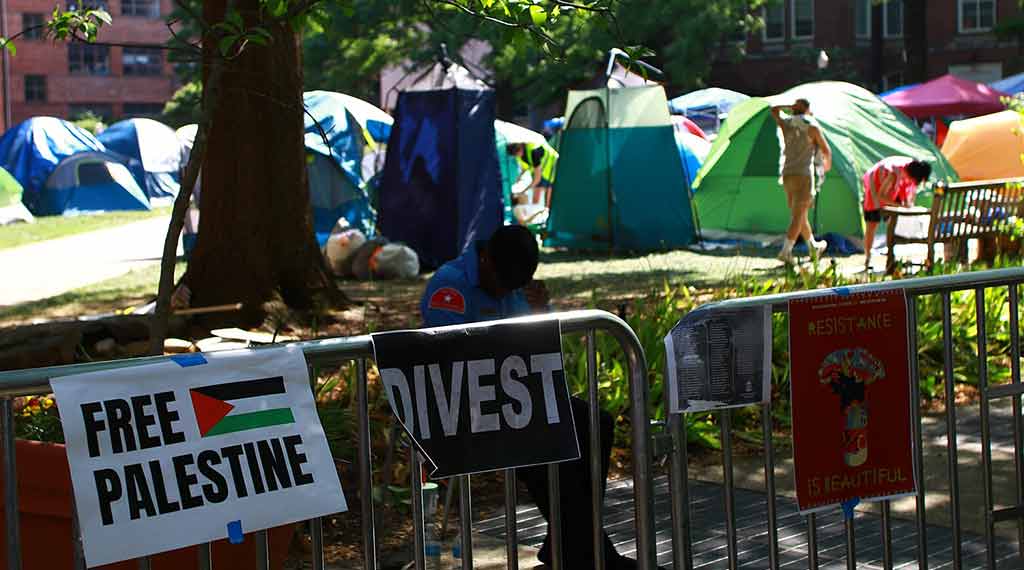
Editor’s Note: This piece by Park MacDougald features quotes from CSP Director and Senior Analyst for Homeland Security and Counterterrorism, Kyle Shideler.
Over the past several weeks, Americans have witnessed what has seemed like a mass outpouring of support for terror on elite college campuses. At Columbia, Yale, Princeton, NYU, UCLA, Northwestern, Texas, and elsewhere, masked mobs have occupied schools with tent encampments, established self-proclaimed “autonomous zones,” clashed with police, harassed and threatened visibly Jewish students, and issued demands for their universities to divest from Israeli “genocide.” Politically, moreover, the protests have displayed an incoherent mix of campus progressivism, hardcore Islamism and Arab nationalism, and revolutionary anarchism and communism, including open praise for North Korea. The only unifying thread would appear to be opposition to Israel and its alleged imperial patron, the United States.
Have America’s college students suddenly converted en masse to anarcho-communist-jihadism? Not quite. Many are far left and anti-Israel. Some are foreigners, or the children of foreigners, who have imported the conspiracies and hatreds of their homelands. More, admitted under relaxed pandemic-era admissions standards and proudly ignorant of both American and world history, are taking the “decolonial” half-knowledge pushed by their elders to its logical conclusion.
…
“What you’re seeing is a real witches’ brew of revolutionary content interacting on campuses,” says Kyle Shideler, the director for homeland security and counterterrorism at the Center for Security Policy in Washington, D.C., and an expert on far-left domestic extremism. “On the left-wing side, you have a broad variety of revolutionary leftists, who serve as rent-a-mobs, providing the warm bodies for whatever the leftist cause of the day is. And on the other side you have the Islamist and Palestinian networks: American Muslims for Palestine and their subsidiary Students for Justice in Palestine, CAIR, the Palestinian Youth Movement. We’re seeing a real mixture of different kinds of radical foment, and it’s all being activated at the same time.”
…
These groups, Shideler says, typically operate in a decentralized manner, using successful tactics drawn from decades of anarchist organizing and spread through left-wing activist networks via word-of-mouth, as well as through formal trainings by professionals such as Fithian or the nonprofit “movement incubator” Momentum Strategies. “If you look at Fithian,” he says, “she has consulted with hundreds of groups on how to do these things: how to organize, how to protest, how to make sure your people don’t go to jail, how to help them once they’re in jail.” There is no one decision-maker; rather, decentralized “affinity” groups work together toward a shared goal, coordinating out in the open via social media and Google Docs. This can create an impression of centralized planning. Shideler cites the matching tents that have cropped up on a number of campuses, prompting speculation that some shadowy entity is buying them en masse. “People keep pointing out, They all have the same tent!,” he says. “Well, yeah, it’s because the organizers told them to buy a tent, and sent around a Google Doc with a link to that specific tent on Amazon. So they all went out and bought the same tent.”
| This file is made available under the Creative Commons CC0 1.0 Universal Public Domain Dedication. |
- How Trump’s Antifa Terrorism Sanctions Could Throttle Its Global Support Network - November 29, 2025
- Terrorist Designation for Muslim Brotherhood a Huge Blow: Kyle Shideler - November 25, 2025
- Antifa groups designated as FTOs - November 17, 2025
